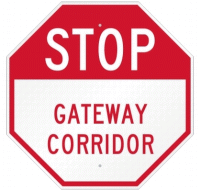Once upon a time, this sign was the only sign a train needed.
When did railroad tracks and a road become a light railroad?
There seems to be a progression of light rail development in Minnesota:
-- from the
Hiawatha Line running mostly along side of Highway 55
-- to
Central Corridor running
on University Avenue
-- to the
Gateway Corridor fiasco running
on residential streets -- by several schools and hundreds of houses. Running on their property!
What's next --
through houses,
through schools, and
through playgrounds?
It gets complicated. According to this sign, we can cross the tracks perpendicularly, but otherwise we have to drive along the tracks.
Is this sign telling us that the train is in the right lane or that we should be in the right lane? Which is it?
Do not drive on the tracks. That's clear. Except, how is the train to get anywhere if it can't drive on the tracks?
Do not be a passenger? Do not successfully cross in front of a train? What does this mean?
The rules of the road become far more restrictive with a train on it.
No left turn. No parking. No buses. No trucks. Block driveway? There's no room to use a driveway. And many streets will be cut off. Remember, the priority is the train. Traffic lights will be added and will change for the train. Traffic congestion will need a decongestant. The traffic decongestant will cost another billion dollars.
Watch out for the train! If you think the train will always be on the right side of the tracks, don't bet your life on it. If you think your SUV will take the impact of a 25+ ton train, think again. You are no longer the monster truck of the road. You might as well be on a bike.
Children haven't been in many accidents yet, but that's part of the long list of problems with Gateway Corridor's plans for St. Paul. Weekday afternoons, kids walk home from school. That's the way things are in this part of town.
There is
no way the train can travel slow enough to brake in time, especially on these sloping streets. Not for children, the elderly, the pets, or the wildlife.
Maybe they can just say no to pedestrians. Or children aren't allowed to live in the neighborhood.
Or have some sort of mandatory
Train-Dangers Kindergarten for the neighborhood.
Light rail can't fund itself (for construction or operation) so its reason for existence is ridership. Except the Gateway Corridor project doesn't
project having ridership. So its goals are
anything. It is a tourist train --
see St. Paul's Eastside! It's a fast commute from eastern suburbs. It's a slow local train. And it's an economic development train, that will close existing businesses.
Beacon Bluffing: Light rail will run on the street.
Home Depot: How will that help a Home Depot store? Will the train have a lumber-loading car?
All this for a relatively-quiet residential neighborhood. With
trees.
Here comes the 25 ton (when empty) train. How quiet is it? How quiet are trucks? Ride the relatively-level Hiawatha Line through its turns. Then imagine the elevation-changing, zig-zagging Gateway Corridor train. Not quiet. Then imagine the trains and the tracks aging. Not quiet at all.
Light rail accidents happen. When the route is kept away from people and vehicles, there are fewer accidents. Accidents will be colossal if planners put tracks on residential streets.
But the
signs will stop people from doing stupid things, right?
Stop Gateway Corridor.
"We talked about changing the T signs to M signs to represent Metro as in Metropolitan Council and Metro Transit. Well, a certain person from a certain Capital city said that M also stands for Minneapolis. That's the last time I bring cupcakes to a meeting, you know, the ones with the bright artificial-colored frosting? Some of those went flying like paintballs, marking everything and everyone. When the giant paintballs were gone, I found out that the T signs are TO signs, as in, 'I'm going TO somewhere' or 'I'm going TO get more cupcakes.'"











































